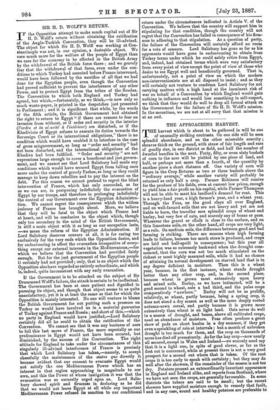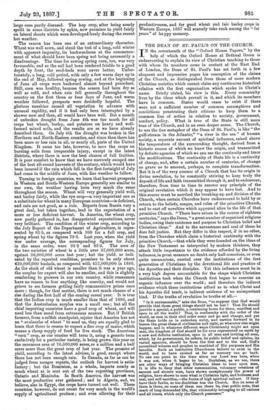THE APPROACHING HARVEST.
THE harvest which is about to be gathered in will be one of unusually striking contrasts. On one side will be seen splendid abundance, and on the other miserable scarcity ; sheaves thick on the ground, with straw of fair length and ears of goodly size, in one district or field, and half the number of dwarfed bundles in the next. Forty, fifty, or even sixty bushels of corn to the acre will be yielded by one piece of land, and half, or perhaps not more than a fourth, of the quantity by another piece a short distance off. One variety of corn will figure in the Crop Returns as two or three bushels above the "ordinary average," while another variety will probably be returned as only half a crop. Farmer Robinson will receive for the produce of his fields, even at current low prices, enough to yield him a fair profit on his capital, while Farmer Thompson will not be able to meet his landlord's demand for rent. This is a heavy-land year, a high farmer's year, and a wheat year. Through the Fens, on the good clays all over England, and on well-farmed soils that are not heavy and yet are not liable to burn, the traveller sees splendid crops of wheat and barley, but very few of oats, and scarcely any of beans or peas. Wherever the gravel or clialk is close to the surface, and on thin limestone soils, on the other hand, all crops are very light, as a rule. On medium soils, the difference between good and bad farming is striking. There are seasons when high farming leads to failure, because too much straw is produced, and crops are laid and half-spoilt in consequence ; but this year all vegetation was so extremely backward when the drought com- menced, that the corn was not too much stimulated on the richest or most highly manured soils, while it had no chance of attaining its normal development on starved land that is in any degree deficient in moisture. Then this is a wheat year, because, in the first instance, wheat stands drought better than any other crop, and, in the second place, because wheat is grown most extensively upon heavy and mixed soils. Barley, as we have intimated, will be a good second to wheat, oats a bad third, and the pulse crops comparatively "nowhere." Barley will not be as prolific, relatively, as wheat, partly because, being a spring crop, it does not stand a dry season as well as the more deeply rooted autumn-sown cereal, and partly because it is grown more extensively than wheat is on light land. Oats never do well in a season of drought, and beans, above all cultivated crops, need an abundance of moisture. Peas often produce a great show of pods on short haulm in a dry summer, if they get even a sprinkling of rain at intervals ; but a month of unbroken drought is too much for them, and the crop on thousands of acres has died off prematurely. As for the hay crop—now nearly all secured, except in Wales and Ireland—we scarcely need say that it is a light one, in spite of good clover, as far as the first cut is concerned, while at present there is not a very good prospect for a second cut where that is taken. Of the root crops it is too early to speak with certainty ; but they may do well after the showers, if the remainder of the season is not too dry. Potatoes present an extraordinarily luxuriant appearance in England and Ireland alike, and reports from Scotland, where we have not seen the crops, are generally favourable. In some districts the tubers are said to be small ; but the recent showers have supplied moisture enough to remedy that fault, and in any case, sound and healthy potatoes are preferable to
large ones partly diseased. The hop crop, after being nearly spoilt in some districts by aphis, now promises to yield fairly on lateral shoots which were developed freely during the recent hot weather.
The season has been one of an extraordinary character. Wheat was well sown, and stood the teat of a long, cold winter with apparent impunity, its backwardness at the commence- ment of what should have been spring not being necessarily a disadvantage. The time for sowing spring corn, too, was very favourable, and as the soil had been rendered friable to a good depth by frost, the seed-beds were never better. Unfor- tunately, a long, cold period, with only a few warm days up to the end of May, followed spring sowing, and at the beginning of June all crops were backward almost beyond precedent. Still, corn was healthy, because the season had been dry as well as cold, and when rain fell generally throughout the country on the first three or four days of June, and warm weather followed, prospects were decidedly hopeful. The glorious sunshine caused all vegetation to advance with unusual rapidity, and if it had only been interrupted by a shower now and then, all would have been well. But a month of unbroken drought from June 4th was too much for all crops but wheat, barley, and potatoes on heavy and well- farmed mixed soils, and the results are as we have already described them. On July 4th the drought was broken in the Northern and North-Eastern counties, and since then there has been more or less rain in all, or nearly all, parts of the United Kingdom. It came too late, however, to save the crops on burning soils from irreparable injury, except in the latest districts, where there is now the best chance of full fruition. It is poor comfort to know that we have narrowly escaped one of the best all-round harvests of the century, which would have been insured if the rain which fell in the first fortnight of July had come in the middle of June, with fine weather to follow.
Turning to foreign countries, we learn that harvest prospects in Western and South-Western Europe generally are similar to our own, the weather having been very much the same throughout the season. Wheat will very generally yield well, and barley fairly, while the rye crop—a very important one as a substitute for wheat in many European countries—is deficient, and oats are not good, as a rule. Reports from Russia vary a great deal, but taken together, lead to the expectation of a more or less deficient harvest. In America, the wheat crop, now partly gathered in, has disappointed expectations, never very brilliant. The condition of the winter crop, according to the July Report of the Department of Agriculture, is repre- sented by 83.5, as compared with 100 for a full crop, and spring wheat by the figures 798. Last year, when the yield was under average, the corresponding figures for July, in the same order, were 91.2 and 83.3. The area of the two varieties of wheat is a little over 37,000,000 acres, against 36,806,000 acres last year ; but the yield, as indi- cated by the reported condition, promises to be only about 430,000,000 bushels, as compared with 457,000,000 in 1886. As the stock of old wheat is smaller than it was a year ago, the surplus for export will also be smaller, and this is slightly comforting to growers in our own country, while consumers have no reason to fear anything like scarcity, and would not grieve to see farmers getting fairly remunerative prices once more ; though, for that matter, there is not much chance of a rise during the first half of the coming cereal year. It is true that the Indian crop is much smaller than that of 1886, and that the Australasian surplus was a small one ; but all the chief importing countries have a good crop of wheat, and will need less than usual from extraneous sources. But if British farmers, from a selfish standpoint, rejoice that America has not an " avalanche of wheat " to send us, they are equally glad to learn that there is reason to expect a fine crop of maize, which means a cheap supply of food for live stock. The American "cons" crop, as our cousins will term it, using a generic term exclusively for a particular variety, is being grown this year on the enormous area of 76,500,000 acres, or a million and a half sores more than the great crop of last year. The promise of yield, according to the latest advices, is good, except where there has not been enough rain. In Canada, as far as can be judged from meagre reports, the outlook for harvest is satis- factory ; but the Dominion, as a whole, imports nearly as much wheat as is sent out of the two exporting provinces, Ontario and Manitoba. In South America, the harvest was the most productive ever gathered ; and in Algeria, and, we believe, also in Egypt, the crops have turned out well. These countries, however, do not count for very much in the world's supply of agricultural produce ; and even allowing for their productiveness, and for good wheat and fair barley crops in Western Europe, 1887 will scarcely take rank among the " fat years" of ha ppy memory.



































 Previous page
Previous page